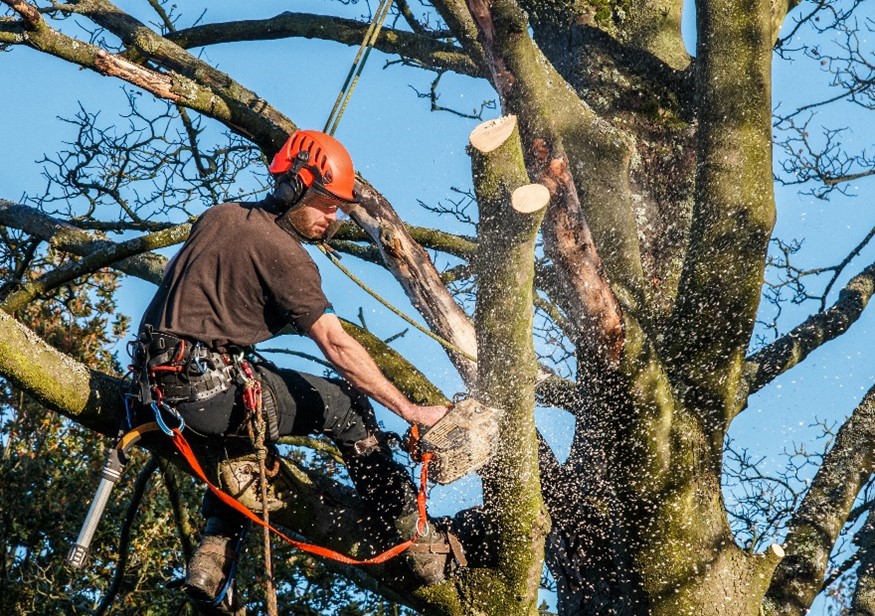
Tree trimmers encounter heights, slippery conditions, falling limbs, sharp equipment, and electrical wires. Each year, tree care injuries account for about 80 worker deaths and at least 23,000 chainsaw injuries across the U.S. While landscape service workers comprise less than 1% of the total workforce, they account for about 3.5% of all workplace fatalities. Fortunately, these injuries and deaths are preventable when employers provide proper training and follow these tips:
1 Provide personal protective equipment (PPE)
Provide employees with free PPE, including hardhats, climbing spurs, harnesses, saddles, and climbing lines. Ensure that employees know how to use all PPE correctly and inspect it before each use.
2 Identify and avoid hazards before starting the job
Conduct daily job site surveys to identify risks, ensure safety compliance, and monitor workers for exhaustion or heat-related illnesses. Train employees to know the risks and adjust their work as needed.
3 Stay clear of power lines
Assume all power lines are energized. Keep work at least 10 feet away from overhead power lines (and more than 10 feet if the voltage to ground is over 50 kilovolts). Call the power company to de-energize and ground the power line when needed. Train employees to use extreme caution when moving ladders and other equipment near power lines.
If clearing trees after a natural disaster, ensure that workers have no direct contact with an energized conductor, such as a power line, and no indirect contact with an energized conductor, such as a tree limb or metal tool touching a power line. Ensure workers do not stand close to grounding elements.
4 Use proper fall protection and climbing techniques
Decide if a worker needs to climb or use an aerial lift. Ensure they use climbing belts, harnesses, and saddles properly and receive climbing gear that matches the tree size. Most falls during climbing occur because workers either disconnect from their climbing lines while repositioning themselves or when the branch they are using for their anchor tie-in-point breaks. Most falls from aerial lifts are caused by workers not properly wearing fall protection systems. Train employees about these hazards and the importance of wearing fall protection. Despite any complaints about lack of comfort, proper fall protection can be the difference between a minor incident and death.
5 Stand clear of drop zones
Mark an area on the ground at least two times the tree's height to avoid working where trimmings or tree removal may fall. Establish a verbal and visual communication system that the trimmer can use to inform ground workers to stand clear when an overhead hazard exists.
6 Plan a retreat path when felling a tree
Felling a tree means to cut the tree so that it falls in the desired direction to prevent damage to the tree and surrounding structures. Train chainsaw operators to determine the felling direction and plan a retreat path to reach safety while the tree is falling. The chainsaw operator should know the location of everyone before felling a tree. Train the ground workers holding the lines to stand at least one-and-a-half times the tree's height away from the tree. Keep uninvolved workers at least two times the tree's height away from the tree.
7 Evaluate the strength of the tree
Prepare for potential hazards when removing dead trees, broken branches, or attached vines. The top of dead trees can break under pressure. When a tree is cut, branches, vines, or other objects may get thrown back toward the worker. Avoid felling a tree into other trees. Use a qualified arborist to ensure the tree's condition can support the rigging force and the weight of lowering tree sections.
8 Keep saws sharp
Sharpen blades and chainsaw cutters often. Replace them when necessary. Know the capabilities and limitations of all cutting equipment and machinery.
9 Know the signs of heat-related illness
Most DWC-authorized OSHA outreach instructors bring 25 to 30 years of safety experience from various industries. All instruction includes high-quality safety and health training that follows strict OSHA regulations. Students can expect instruction that includes real-world safety and health scenarios, required class participation, and proof of comprehension.
For more information on tree trimming safety, download DWC's Tree Trimming and Removal Safety Fact Sheet or review the Occupational Safety and Health Administration’s tree trimming guidelines at Tree Care Industry Hazards and Solutions.
